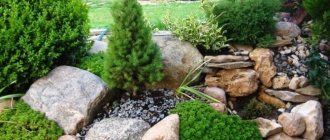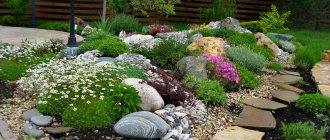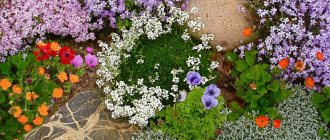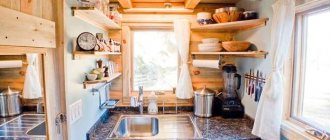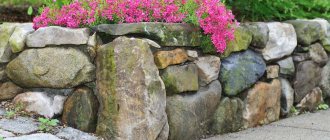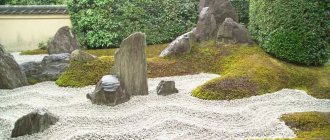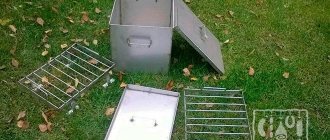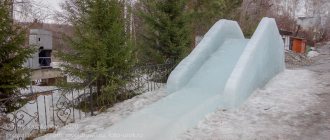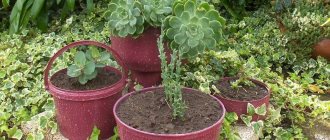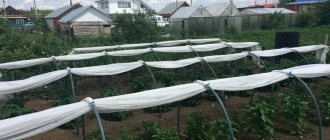Types of stone flower beds
You can make the appearance of a flower bed out of stones at your discretion. Based on generally accepted principles, they all differ into 3 groups.
A rock garden (alpine slide) can be of different styles and sizes, but has one distinctive feature: the obligatory combination of mountain vegetation and stones. It can be collected due to natural elevation changes on the site or using bulk soil. Divided into several types:
Exterior view of the rocky hill Source yandex.ru
- Rocky hill. The stones are piled up like a kind of hill. The peak is crowned by a medium-sized fragment, reminiscent of the top of a mountain.
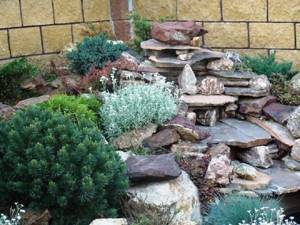
Terrace made of flat stones Source tinyfriendsanimalrescue.com
- Terrace. It is assembled from flat stones, most often flagstone is used for this. It is made of several tiers resembling steps.
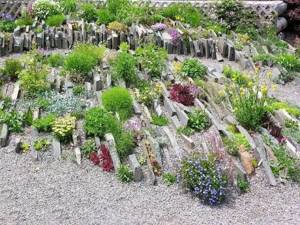
Flagstone flowerbed Source domnomore.com
- Czech rolling pin. Just like in the terrace, flat flagstone is used. It is installed on an edge, forming an arrangement of mountain ridges. Everything between them is covered with soil to no more than half the height of the stone.
- Retaining wall. It is used as a skillfully decorated strengthening of the slope of the site.
A rockery is a kind of flowerbed in which stones predominate. Another name is “Stone Garden” or “Stone Flowerbed”. A distinctive feature from a rock garden is that first of all, attention is attracted by cobblestones and crushed stone bedding, and only after that the visual switch occurs to secondary details: greenery.
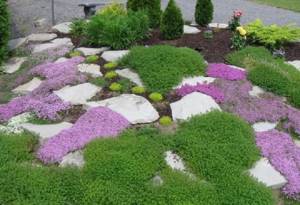
Original flower bed Source sheherazadenyc.com
- European. Planted with ground cover perennials characterized by abundant flowering: aubrietta, arabis, tenacious.
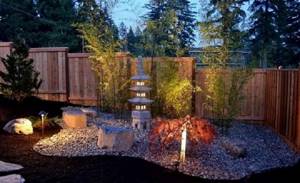
Flowerbed in Asian style Source mercabadom.ru
- Japanese. A large number of stones and a minimum of vegetation. Flowers are planted in rare places. It is better to use unpretentious herbs and grains: fescue, golden beard, reed grass.
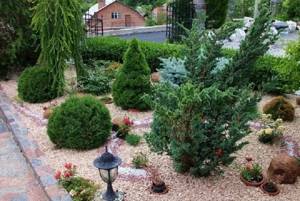
Strict British flowerbed Source giropark.ru
- English. Its appearance is reminiscent of the vegetation of Foggy Albion with a predominance of coniferous, low-growing species: spruce, juniper, pine.
A flowerbed is a definition of a flower garden that we all understand from childhood, in which stone is used only as a frame. Characterized by appearance and structure, they are divided into 4 groups:
- Elated. Enclosed by a stone parapet. Can be of different heights: from 30 to 100 cm.
Important! To avoid spreading, use cement mortar.
See also: Catalog of companies that specialize in landscaping work on sites.
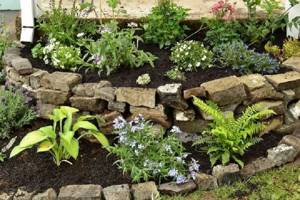
Several levels Source spainproject.ru
- Multi-level. It looks like a cascade consisting of several steps. Each tier acts as a separate flower bed.
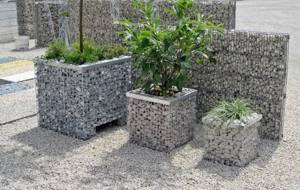
Gabion design Source dacha-ogorod.com
- Gabion. A model assembled from a medium-sized stone placed in a metal frame. Configuration and height may vary.
- Border. The soil level in the flower garden remains at the same height or rises, but only slightly. The frame protrudes only 10-15 cm.
The use of natural stone in landscape design
Natural stone is one of the most versatile materials for creating a garden landscape. In the East, stone is considered the personification of the greatness and perfection of nature - and it is difficult to disagree with this.
What types of stone are best suited for decorating a site?
- Granite. High strength, unaffected by the environment. Shades from black to red.
- Basalt. Volcanic origin, less durable than granite. Painted in black and gray tones.
- Slate. Flat stones with a layered structure. Variety of colors: from light gray to black, from greenish to pink.
- Tuff. Durable material, suitable for construction. Color: brownish, beige shades.
- Marble. Strong rock. Shades: from white to black, from pink to yellow.
- Sandstone. Soft rock, layered. Shade: grayish-brown or yellowish, but boulders are also found in reddish tones.
How are stones used in landscape design?
- Paving. The stone is well suited for creating paths. You can make platforms from flat stone, from which paths extend.
- Retaining walls. Terraces and multi-level flower beds on walls made of blocks look impressive on a personal plot. With their help you can delimit space.
- Steps. The steps are made of flat slabs with uneven edges. They go well with a hearth, a place to relax, and bridges.
- Garden benches. When arranging a corner for relaxation, a place near the fireplace, you can create benches made of stone.
- Curbs. Guardrails and small fences are made from large blocky boulders or irregularly shaped stones. With their help, site zoning and decorative finishing of paths and platforms are carried out.
- Dry stream. Instead of water, a winding path of small stones is laid out. The composition is decorated with bridges made of wood or stone, and plants are planted along the banks.
- Alpine slide. The composition of large and small boulders imitates natural mountain landscapes. Here you can create slopes and gorges, decorating them with vegetation characteristic of such landscapes.
- Rock garden. This Japanese style is widely known in our country. You will need several large boulders, which are installed at some distance from each other. The rest of the space is covered with sand or gravel.
- Czech Switzerland. An imitation of rocks is created from flat stones. They have different thicknesses and natural shapes. Dwarf plants are planted between the boulders.
- Rockery. Stones in this flower garden should occupy at least 60% of the area. Boulders can come in different sizes, shapes and types. Only 40-20% of the rockery area should be occupied by plants.
- Installation. You will need pebbles or crushed stone, which are placed in wooden or metal structures.
- Flowerbed. Typically, rounded, streamlined shapes are used for this method of designing a personal plot. They can be single-level or multi-level, the plants are mostly flowering.
- Gabions. These are metal mesh structures filled with stones.
- Patio. This is a barbecue area, which is usually adjacent to steps. They are made almost entirely of stones.
- Glowing stones. These are boulders covered with a layer of special luminescent paint.
When decorating a site with stone compositions, you need to work out every little detail. All elements must be combined, merging into a single picture. Then the landscape will be harmonious, and it will be pleasant to be here.
Don't be afraid to experiment and create your own masterpieces!
Material selection
It is allowed to use various rocks as the main material for arranging a flower bed. These can be natural stones, bricks left over from a construction site, or hand-poured concrete blocks of the required size.
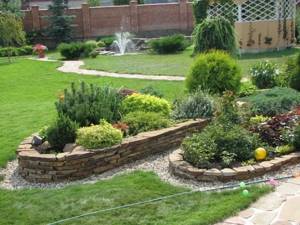
Flowerbed in a small garden Source Ognezaschita
- The advantage of limestone and pebbles is that the rocks have a varied palette of shades: yellow, cream, gray, pink. They look good in combination with moss, algae, and near artificial reservoirs.
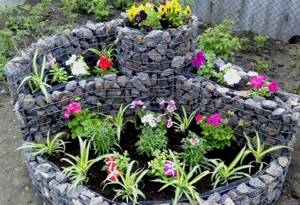
Flowerbed made of stone Source sk.facebook.com
- The disadvantage of using sandstone is that the rock is susceptible to destruction under the influence of wind and water. Despite this, due to the wide range of colors it is used everywhere.
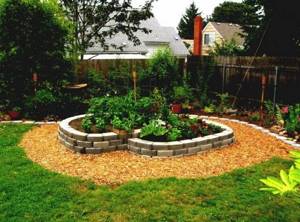
Processed Volcanic Tuff Source sunvalleyvacationhomerentals.com
- Volcanic tuff is a durable but easily processed material. Has a wide range of shades. Looks great in flower beds planted with creeping and climbing plants.
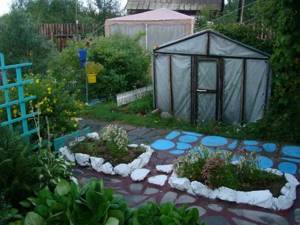
Slate flower bed Source plotnikov-pub.ru
- Due to its layered structure, slate is often used to form raised flower beds. The ability to exfoliate into thin plates makes it very popular in landscape design.
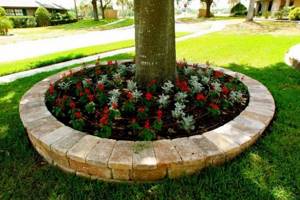
Round flower bed made of granite Source hug-fu.com
- Granite, quartzite, basalt are some of the most durable stones used for arranging flower beds. Create a lasting impression in sunny areas. The visual effect is enhanced by the abundance of colors and smooth, shiny surface.
Important! Please note that granite can oxidize the soil. Therefore, the choice of plants for such a flower bed will be limited.
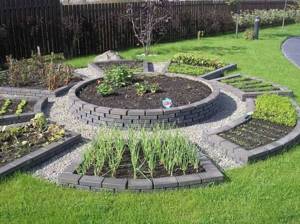
Original flower garden Source diabacorreview.com
- Brick, paving stones or other concrete products, due to their correct geometric shape, will serve to assemble a beautiful fence for a flower bed of any shape. The classic type of materials harmonizes well in flower beds of almost any configuration.
Consequently, any type of stone can be used to arrange a flower bed in a garden plot. It is enough to use a little imagination and the material at hand.
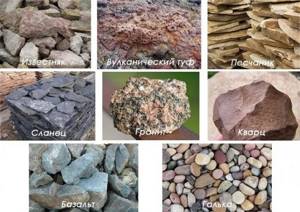
Types of decorative stone for flower beds Source idei-landshafta.ru
artificial stones for manholes and septic tanks for landscape
The decorative stone is quite simply dismantled, so you can always move the structure to another place, if necessary, quickly get to the septic tank or hatch on which it is installed, which makes it easy to carry out service work at various technical sites.
Sale of artificial stones and boulders for manholes and septic tanks
Our company is engaged in the production and sale of decorative artificial stones-boulders for hatches and septic tanks for the garden from natural stone chips. We produce artificial stones of any diameter and with any image to order.
We bring to your attention a series of artificial stones that are as realistic as possible and close to their natural appearance: boulder stones and flowerpot stones. The series is presented in several colors, completely imitating crushed rocks and natural boulders.
Main characteristics of boulders
The technology for the production of artificial stones for hatches based on polymer resins with the addition of natural boulder crumbs is the most effective. Externally, the structure looks quite massive and fundamental, but at the same time the decorative stone has a small specific weight (7-9 kilograms to cover a hatch with a diameter of 80 cm). The frame of the boulder is made of fiberglass, the lining is made of natural stone chips of quartz, granite, jasper, granite and other rocks. If necessary, the stone can be drilled with a concrete drill, or cut using a diamond blade.
Artificial decorative stone is made from a material suitable for Russian conditions that copes with any natural and climatic factors. Stones tolerate high levels of humidity, frequent precipitation, sudden temperature changes and severe frosts. Even under conditions of intensive use, the artificial decorative boulder does not lose its original characteristics, does not crack, and retains its visual appeal.
Advantages of using decorative stones
- environmentally friendly solution,
- simple installation and dismantling system,
- the ability to fit the product into absolutely any landscape design option,
- wide color palette of artificial boulders,
- complete imitation of the surface of natural stone,
- the possibility of installing artificial stone on a hatch, flower bed, septic tank, reinforcement protruding from the ground and other structures,
- affordable price of products,
- long service life without loss of original technical characteristics.
We offer our clients favorable terms of cooperation: reasonable prices for all types of decorative stones, delivery and installation on site in the shortest possible time, quality guarantee. If you need to order a decorative stone-boulder, consult on selection issues, contact the company’s managers by phone or read the information presented on the website.
Making a flowerbed out of stones: a clear step-by-step algorithm
The flowerbed fencing can be built in a single layer or by raising it over several rows of bricks. Depending on this, the installation method will also change: using a cement-sand mortar, without it, or assembling the walls with filling the cracks between the stones with ordinary soil.
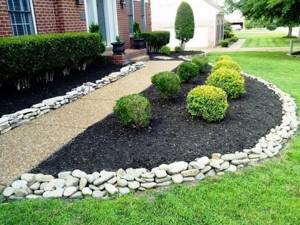
Low-growing bushes in landscape design Source landshaftdizajn.ru/
Brick flowerbed
As an example, let's look at one of the simplest ways to make a flower bed - assembling it from brick. The work order is as follows:
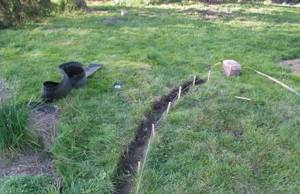
DIY flowerbed in the garden Source raflon.ru
- Marking the site of the future flower bed is carried out using pegs and thread.
- A trench is dug along the intended trajectory, 20-30 cm deep.
- 10 cm of fine gravel and the same amount of sand are poured to the bottom.
- It is spilled with water, carefully compacted, leveled.
- For rigid adhesion of bricks, cement mortar is used, mixed in a ratio of 1 to 3.
Important! When arranging a flowerbed from the “Border” category, 1-2 rows high, the use of a cement-sand mixture can be eliminated. For taller people it is a must.
- The masonry is done according to the classical scheme, with the next row overlapping half of the bottom one. This will allow you to achieve better structural strength indicators.
- Periodically check the plane and angle of inclination with a building level.
- Backfilling with soil is carried out no earlier than one day after completion of work with the stone.
Flowerbed made of stone and cement
Laying flower beds from natural stone of non-standard sizes requires more careful attention and responsibility. This is done as follows:
- The fertile layer of soil is removed along the designated perimeter, depth: 20-30 cm.
- Sand and gravel filling is made. It is spilled with water, compacted, leveled.
- The stones are placed after careful sorting. Large ones go down, gradually decreasing as they rise.
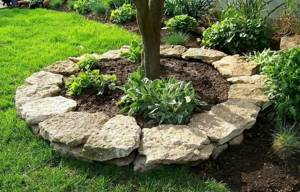
Stone flowerbed around a tree Source twitter.com
- The boulders are moved repeatedly in order to achieve maximum contact with each other.
Filling joints with cement mortar occurs in one of two ways:
- The mixture is laid during the laying process. The seams between the stones remain clean, making them look more natural. The disadvantage is that water gets into the cracks and the likelihood of subsequent defrosting, which can lead to partial destruction of the flowerbed.
- Filling all seams and voids between stones. It is done on both sides. The mortar will be visible, but the masonry will be strong and will last much longer.
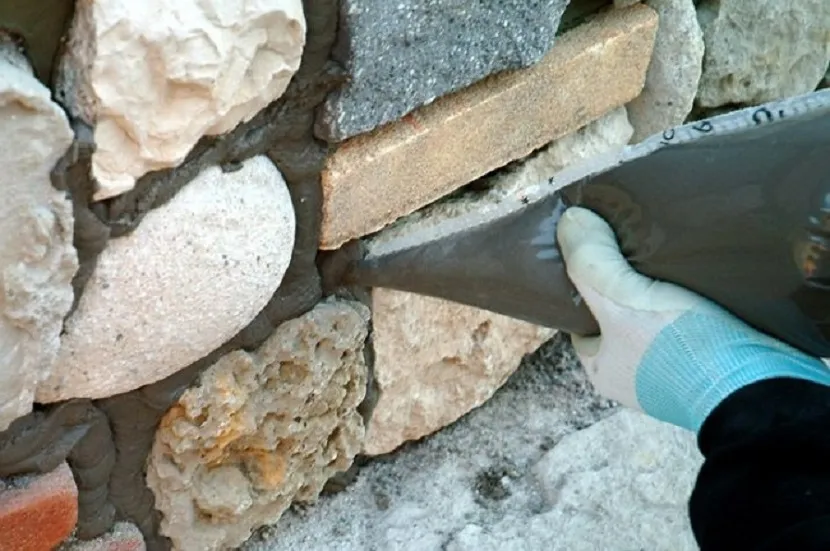
Coating with solution Source twitter.com
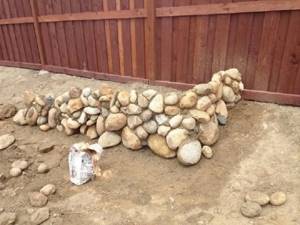
The filling of fertile soil is carried out no earlier than one day after the completion of the masonry.
Subtleties of work, secrets of a beautiful flower bed
The main secret to creating a beautiful flower bed made of stone is to adhere to several principles that are common to all options:
- The flower garden should please the eye. Place it in a visible place: near a wall or in the center of the garden.
- The choice of seedlings is determined based on microclimatic conditions. This is especially true for light-loving plant varieties.
- Pay attention to the size and flowering period of the plantings. Using annual flowers risks the fact that at a certain period of time your flowerbed may be empty.
- The appearance of the flower garden should be correctly combined with a single ensemble of the entire garden.
To lay a stone flower bed, one of several methods can be used, depending on the result that should be achieved:
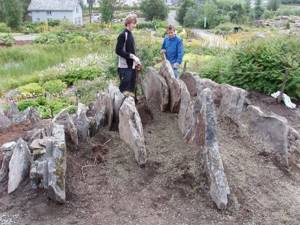
Beautiful flower garden using stone Source one-stroy
- When arranging an alpine slide in the Czech rolling pin style, flat stones are placed in a vertical position. For the Terrace Garden - horizontal.
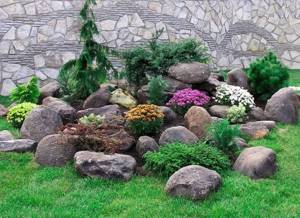
Flowerbed-rockery on the site Source forum-obscheniya
- A rockery does not necessarily imply the presence of sides. The only condition for laying stones here is their uniformity.
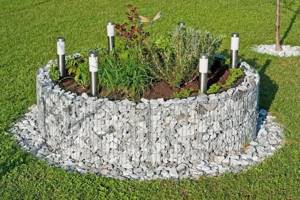
Gabion in the garden interior Source siegmundlandscape.com
- One of the most complex is the construction of gabions. For construction, you will need a metal frame into which stones belonging to the same breed are placed.
On the other hand, you can ignore all these conventions and organize a flower bed at your own discretion. It is enough to express your desire, use your imagination, and select suitable materials and vegetation.
Raised garden bed made of stone and cement
Choosing this type of flower bed can be a stylish and practical solution for your garden at the same time. The key advantage is its design, which makes growing flowers possible in any soil. In addition, a raised flower bed can visually increase the area of a small area. Multi-level compositions will further enhance the visual effect.
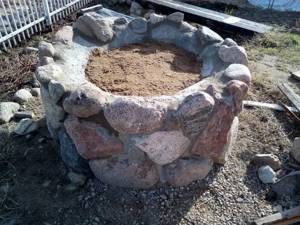
DIY flower garden Source drive2.
Other advantages of a raised flower bed include:
- Protection against weeds and some pests. You won't have to bend down repeatedly while caring for plants.
- It becomes possible to grow rare varieties of flowers that require a special soil composition. For example, hydrangea and conifers, which prefer acidic soils.
Among the disadvantages you need to consider:
- Increasing frequency of watering - the soil at higher elevations dries out faster than below.
- Construction capital. Depending on what is planned, this may take more than one day.
Important! Proceed with arranging a raised flower bed only after you have weighed all the advantages and disadvantages.
Types of stone by shape
This systematization of natural stone takes into account the shape of the elements, its dimensions and other geometric features.
Flagstone
Represents plates of stone of natural origin. The flat shape is obtained as a result of the breakdown of rocks into separate planes. Available in natural and tumbled surfaces (the edges are treated with water pressure) to achieve maximum smoothness. The size of the elements is from 1 to 6 cm.
Scope of application in design
- Paving. The rough surface does not slip, and a wide selection of products with different thicknesses allows you to use flagstone to design pedestrian paths and entrance areas.
- Facing. The thickness of the stone should be from 1 to 3 cm for ease of fastening to a vertical surface and reducing the load on the wall.
- Production of tiles and paving stones. For ordinary tiles, flagstone with a thickness of 1-7 cm is used (depending on the purpose of the finished product), and for thick paving stones - with a thickness of 10-20 cm.
- Design of alpine slides. Also suitable for decorating ponds, fountains, and other landscape design elements.
The material for flagstone (stone type) is selected depending on the area of use and the desired visual effect. For example, zlatolite is able to change shade depending on the lighting, it is also well polished, and lemesite after polishing acquires a brighter shade and is universal in use due to its strength.
Pebbles
A durable and resistant stone that is not afraid of moisture and temperature changes. A wide palette allows you to design reservoirs, turning them into panels, as well as create a mosaic on the site.
Types of pebbles
- Marine. Polished by sea surf. It has a flat shape and a variety of colors. Used to create gabions, paths, cover areas, and design imitations of a water source.
- Gray. It is characterized by uniform color and glossy surface. It is used for arranging paths with the creation of exclusive patterns. Thanks to its ideal geometry, it is pleasant to walk on with bare feet, so it can be used for the entire territory.
- Caspian. It comes from sedimentary rocks and has a flat shape. Thanks to its flattened shape, it can be used for alpine slides with waterfalls, gabions, fountains and even bridges.
- River. In addition to its original appearance, it is highly durable. The variety of sizes and shades allows it to be used for flower arrangements, pools, flower beds, and paths.
The sizes of pebbles are varied, they can be from 1 to 25 cm. The shape and dimensions depend on the type of fragmentary rock, as well as the origin of the natural material.
Boulder
Boulders are large fragments of rocks that can have an irregular or regular shape (obtained naturally as a result of exposure to water and wind). Widely used in landscape design due to the following advantages:
- large selection of textures, colors, shapes and sizes;
- resistance to temperature changes, moisture, mechanical stress;
- environmental friendliness;
- ease of care and use;
- versatility.
Boulders can be from different rocks, most often of metamorphic origin, as high strength is required. The sizes of stones for landscape design vary from 40 to 300 cm. They are used to design Japanese gardens, rockeries, fountains, gabions, framing buildings and plots, and alpine slides.
Crumb (crushed stone)
Decorative crushed stone is obtained by painting using polymer or acrylic based pigments. The dye is resistant to moisture and retains its color brightness for a long time. The coating can be changed if necessary.
Baby functions
- Moisture retention. Due to its good throughput, but retention of moisture in the soil, it is used for flower arrangements, rose gardens, flower beds, and decoration of pots.
- Weed protection. Typically, it is crushed stone that covers the areas of a landscape project where other elements will not stand. This way you won’t have to deal with weeds.
- Unique design. The crumbs can be painted any color. In addition, the size can be from 0.3 to 4 cm, which allows you to create original panels.
The stone can withstand temperature changes and is made from different rocks. Popular types include granite, marble, and limestone types of crushed stone (due to their high strength and durability).
Booth
It is fragments of rocks of various shapes with sizes from 6 to 40 cm. The edges can be sharp and uneven, smooth and naturally polished. It is resistant to moisture, frost, ultraviolet radiation, and other influences.
Coniferous shrubs and trees as decorative elements for stone flower beds
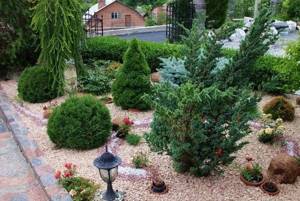
Combination with coniferous plants will be an ideal option if you do not have time to tend to the flower bed every day. Evergreen shrubs are unpretentious and belong to the long-living category. There can be quite a few ways to decorate a flower garden.
The “Silver River” landscape stone flowerbed will act as an island mixborder or will advantageously stretch along the sidewalk. A composition of conifers interspersed with grasses will create a flowing look. It will delight throughout the entire season, almost until the snow.
Consists of the following plant species:
- Juniper scaly "Blue Сarpet".
- Juniper virginiana "Grey Owl".
- Prickly spruce "Glauca Globosa".
- Gray fescue.
- The carnation is grayish-blue.
"Flowerbed with Irises" prefers sunny places. The key form is 2 types of conifers that can maintain their color throughout the year. Irises of any shade look harmonious in the center. Along the edges are plantings of pink spirea resembling lanterns. The composition is easy to maintain and has an original appearance, which allows you to place it near the entrance gate or gazebo.
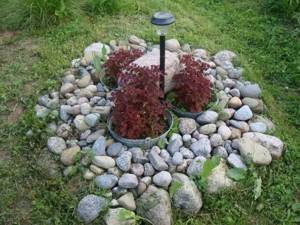
Design option with old buckets Source landshaftportal.ru/
Consists of the following plant species:
- Thuja occidentalis "Globosa".
- Cypress pea fruit.
- Spiraea Boumalda "Froebelli".
- Juniper scaly "Blue Сarpet".
- Iris hybrid.
When arranging a coniferous flower bed made of stone, pay attention to the individual principles of landscape design inherent to this group. They are as follows:
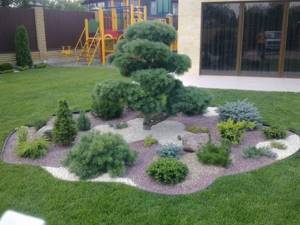
Flowerbed with evergreens Source yandex.ru
- Proportionality is mandatory. Large coniferous mixborders are located at a distance from buildings, fences and other areas of your garden. This is necessary due to the volume of plants that comes with age.
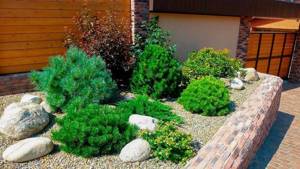
Pay attention to the cardinal directions Source pinterest.ch
- Place the flower bed with evergreens in an east or west direction. This way the plants will receive the right amount of sun, which will have a beneficial effect on development.
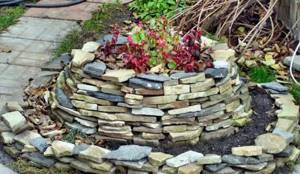
Two tiers of flower beds Source laidbackgardener.blog
- Calculate zone planting so that there is at least 1 m2 of area per coniferous plant. This reserve will compensate for slow growth and will allow the remaining space to be filled with annual grasses.
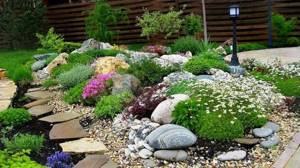
Bright spot of landscape design Source remoo.ru/
